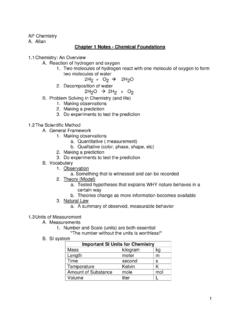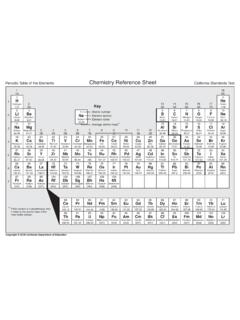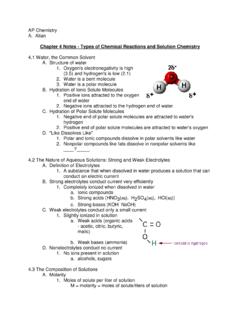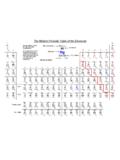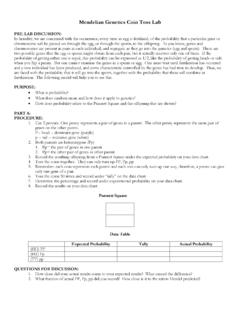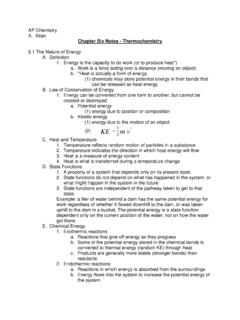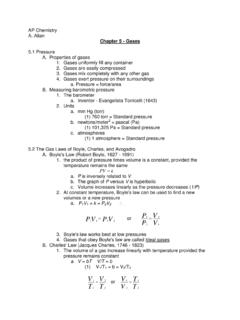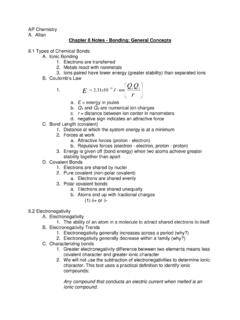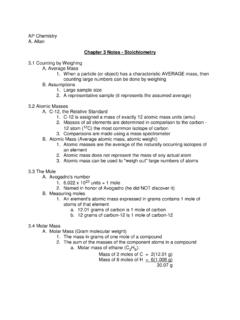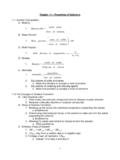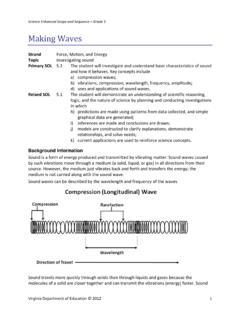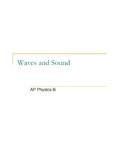Transcription of Chapter 7 Notes - Atomic Structure and Periodicity
1 AP Chemistry A. Allan Chapter 7 Notes - Atomic Structure and Periodicity Electromagnetic Radiation A. Types of EM Radiation (wavelengths in meters) 10-12 10-10 10-8 4 to 7x10-7 10-4 10-2 1 102 104 Wavelength increases Frequency decreases energy decreases Speed is constant = x 108 m/sec B. Properties of EM Waves 1. Wavelength ( ) a. Distance between two consecutive peaks or troughs in a wave b. Measured in meters (SI system) 2. Frequency ( ) a. Number of waves that pass a given point per second b. Measured in hertz (sec-1) 3. Speed ( c ) a. Measured in meters/sec 4. Relationship of properties a. c= gamma xrays UV visible IR micro Radio waves FM short AM The Nature of Matter A. Max Planck and Quantum Theory 1.
2 energy is gained or lost in whole number multiples of the quantity hv Frequency = v Planck's constant = h = x 10-34 J S nhvE= 2. energy is transferred to matter in packets of energy , each called a quantum B. Einstein and the Particle Nature of Matter 1. EM radiation is a stream of particles - "photons" hchvEphoton== 2. energy and mass are inter-related mcE2= C. de Broglie and the Dual Nature of Light 1. Light travels through space as a wave 2. Light transmits energy as a particle 3. Particle's have wavelength, exhibited by diffraction patterns mvh= a. large particles have very short wavelengths b. All matter exhibits both particle and wave properties The Atomic Spectrum of Hydrogen A. Continuous spectra 1. Contains all wavelengths of light B. Bright line spectra 410nm 434nm 486nm 656nm 1.
3 Excited electrons in an atom return to lower energy states 2. energy is emitted in the form of a photon of definite wavelength 3. Definite change in energy corresponds to: a. Definite frequency b. Definite wavelength hchvE== 4. Only certain energies are possible within any atom Bohr Model (Neils Bohr, 1913) A. Quantum Model 1. The electron moves around the nucleus only in certain allowed circular orbits 2. Bright line spectra confirms that only certain energies exist in the atom, and atom emits photons with definite wavelengths when the electron returns to a lower energy state 3. energy levels available to the electron in the hydrogen atom = n = an integer Z = nuclear charge J = energy in joules B. Calculating the energy of the emitted photon 1. Calculate electron energy in outer level 2.
4 Calculate electron energy in inner level 3. Calculate the change in energy ( E) E = energy of final state - energy of initial state 4. Use the equation: Ehc = to calculate the wavelength of the emitted photon C. energy Change in Hydrogen atoms 1. Calculate energy change between any two energy levels = D. Shortcomings of the Bohr Model 1. Bohr's model does not work for atoms other than hydrogen 2. Electron's do not move in circular orbits The Quantum Mechanical Model of the Atom A. The Electron as a standing wave 1. Standing waves do not propagate through space 2. Standing waves are fixed at both ends 3. Only certain size orbits can contain whole numbers of half wave lengths a. fits the observation of fixed energy quantities - "quanta" B. The Schr dinger Equation (Erwin Schr dinger) 1. For the motion of one particle, in the along the x axis in space: EVdxdmh=+ 22228 2.
5 Solution of the equation has demonstrated that E ( energy ) must occur in integer multiples 3. Your book has done you the favor of greatly simplifying this and presents the general equation: EH= H = a set of mathematical functions called an "operator" = a wave function. Specific wave functions are called "orbitals" 4. Orbitals 1. Orbitals are not circular orbits for electron 2. Orbitals are areas of probability for locating electrons C. Heisenberg Uncertainty Principle (Werner Heisenberg) 1. "There is a fundamental limitation on how precisely we can know both the position and momentum of a particle at a given time" 4)(hmvx = xuncertainty in the particle's position = )(mvuncertainty in the particle's momentum 2. The more accurately we know the position of any particle, the less accurately we can know its momentum, and vice-versa D.
6 Physical Meaning of a Wave Function 1. Square of the absolute value of the wave function gives a probability distribution. 2 2. Electron density map indicates the most probable distance from the nucleus 3. Wave functions and probability maps do not describe: a. How an electron arrived at its location b. Where the electron will go next c. When the electron will be in a particular location Quantum Numbers A. Principal Quantum Number (n) 1. Integral values: 1, 2, 3, .. 2. Indicates probable distance from the nucleus a. Higher numbers = greater distance b. Greater distance = less tightly bound = higher energy B. Angular Momentum Quantum (l) (this was called the "orbital quantum number" in your general chem book) 1. Integral values from 0 to n - 1 for each principal quantum number n 2. Indicates the shape of the Atomic orbitals Table Angular momentum quantum numbers and corresponding Atomic orbital numbers Value of l 0 1 2 3 4 Letter used s p d f g C.
7 Magnetic Quantum Number (ml) 1. Integral values from l to -l, including zero 2. Magnetic quantum number relates to the orientation of the orbital in space relative to the other orbitals D. Spin Quantum Number 1. Covered in section Table Quantum numbers for the first four levels of orbitals in the hydrogen atom n l Orbital designation ml # of orbitals 1 0 1s 0 1 2 0 2s 0 1 1 2p -1, 0, 1 3 3 0 3s 0 1 1 3p -1, 0, 1 3 2 3d -2, -1, 0, 1, 2 5 4 0 4s 0 1 1 4p -1, 0, 1 3 2 4d -2, -1, 0, 1, 2 5 3 4f -3, -2, -1, 0, 1, 2, 3 7 Orbital Shapes and Energies A. Size of orbitals 1. Defined as the surface that contains 90% of the total electron probability 2. Orbitals of the same shape (s, for instance) grow larger as n increases B. s Orbitals 1. Spherical shape 2. Nodes (s orbitals of n=2 or greater) a.
8 Internal regions of zero probability C. p Orbitals 1. Two lobes each 2. Occur in levels n=2 and greater 3. Each orbital lies along an axis (2px, 2py, 2pz) D. d Orbitals 1. Occur in levels n=3 and greater 2. Two fundamental shapes a. Four orbitals with four lobes each, centered in the plane indicated in the orbital label dxz dyz dxy dx2- y2 b. Fifth orbital is uniquely shaped - two lobes along the z axis and a belt centered in the xy plane dz2 E. f Orbitals 1. Occur in levels n=4 and greater 2. Highly complex shapes 3. Not involved in bonding in most compounds F. Orbital Energies 1. All orbitals with the same value of n have the same energy a. "degenerate orbitals" (hydrogen only!) 2. The lowest energy state is called the "ground state" 3. When the atom absorbs energy , electrons may move to higher energy orbitals - "excited state" Electron Spin and the Pauli Principle A.
9 Electronic Spin Quantum Number 1. An orbital can hold only two electrons, and they must have opposite spins 2. Spin can have two values, +1/2 and -1/2 B. Pauli Exclusion Principle (Wolfgang Pauli) 1. "In a given atom no two electrons can have the same set of four quantum numbers" Polyelectronic Atoms A. Internal Atomic energies 1. Kinetic energy of moving electrons 2. Potential energy of attraction between nucleus and electrons 3. Potential energy of repulsion between electrons B. The Electron Correlation Problem 1. Electron pathways are not known, so electron replusive forces cannot be calculated exactly 2. We approximate the average repulsions of all other electrons C. Screening or Shielding 1. Electrons are attracted to the nucleus 2. Electrons are repulsed by other electrons 3. Electrons would be bound more tightly if other electrons weren't present D.
10 Variations in energy within the same quantum level 1. Atoms other than hydrogen have variations in energy for orbitals having the same principal quantum number 2. Electrons fill orbitals of the same n value in preferential order Ens < Enp < End < Enf 3. Electron density profiles show that s electrons penetrate to the nucleus more than other orbital types a. Closer proximity to the nucleus = lower energy The History of the Periodic Table No Notes . Read this section. Notice especially Table and The periodic table is as useful for predicting properties of undiscovered elements today as it was in Mendeleev's time The Aufbau Principle and the Periodic Table A. The Aufbau Principle 1. "As protons are added one by one to the nucleus to build up elements, electrons are similarly added to these hydrogen-like orbitals B.
